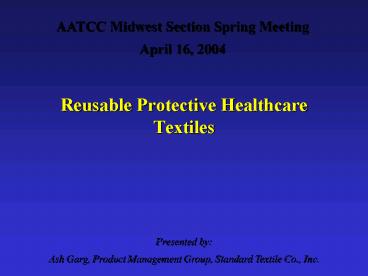Reusable Protective Healthcare Textiles - PowerPoint PPT Presentation
1 / 26
Title:
Reusable Protective Healthcare Textiles
Description:
Prevent the penetration of microorganisms, fluids, or particulates through a fabric. Prime requirement to avoid penetration of liquids to the skin is that the blood ... – PowerPoint PPT presentation
Number of Views:301
Avg rating:3.0/5.0
Title: Reusable Protective Healthcare Textiles
1
Reusable Protective Healthcare Textiles
AATCC Midwest Section Spring Meeting April 16,
2004
Presented by Ash Garg, Product Management
Group, Standard Textile Co., Inc.
2
Hazards in a Healthcare Environment
- Bloodborne Pathogens
- Other pathogenic microorganisms present in body
fluids - Irritants
3
Protective Textiles
- Prevent the penetration of microorganisms,
fluids, or particulates through a fabric. - Prime requirement to avoid penetration of liquids
to the skin is that the blood or other
contaminated body fluids not strike through the
protective garment
4
Hydrostatic Resistance
- A measurement of the relative ability of a given
fabric to withstand pressure infers liquid
resistance - Typically tested on a Suter apparatus, which
creates pressure by an increasing vertical column
of water
5
Hydrostatic Pressure Test
- It measures the penetration of liquids under
steadily increasing pressure. The test consists
of mounting a test sample of clothing under an
orifice of a conical well in the tester and
subjecting it to water pressure increasing at a
constant rate until three points of leakage
appear on its under surface. The hydrostatic head
pressure at the moment of penetration measured in
centimeters is reported.
6
Suter Equipment for Hydrostatic Resistance
Measurement
7
Impact Penetration Test
- The impact penetration test is used to determine
the penetration of liquids upon impact (e.g.,
splash by a liquid during a surgical procedure).
In this test, an AATCC Impact Penetration Tester
is used with blotter paper. The blotter paper is
weighed on an analytical balance and placed under
the surface of sample of clothing material. The
sample is sprayed on its outside surface with 500
mL of liquid from a height of 61 cm. The blotter
paper is then reweighed after exposure to liquid
impact. The increase in weight is reported as the
impact resistance.
8
Impact Penetration Test
9
Surgical Fabrics
- Surgical Wrappers
- Surgical Gowns
- Surgical Drapes
10
Surgical Wrappers
- What are surgical wrappers used for?
- Surgical wrappers are primarily used
- to protect the contents of surgical packs
- from becoming contaminated, allowing
- for aseptic presentation of pack contents.
11
Surgical Drapes
- Fenestrated
- Non-Fenestrated
- Q What is a fenestration?
- A A fenestration is a fixed opening
incorporated into the design of the surgical
drape to facilitate access to the operative site
12
Precaution Gowns
- Hydrostatic resistance of 25-50cms
- Fluorochemical finish
- Reduce the critical surface energy of the
finished fabric - Liquid resistant
- Control spread of infection from the visitor to
the hospital environment and vice-versa
13
Pillow Ticking
- Liquid Resistant Fabric
- Antimicrobial
- Anti-bacterial and Anti-fungal
- Flame Retardant
14
Hamper Bags
15
End User Requirements
- Resistance to bacteria penetration, wet and dry
- Resistance to liquid penetration
- No linting
- Bursting strength, both wet and dry
- Tensile strength, wet and dry
16
Engineering Fabrics with Improved Barrier
Properties
- In order to engineer a barrier fabric to meet the
changing needs, three areas were addressed - 1. Selection of a hydrophobic fiber.
- 2. Construction of a fabric with a small pore
size. - 3. Use of chemical finishes to enhance barrier
performance.
17
Fiber Selection
- Polyester was the likely candidate for a barrier
fabric because it is hydrophobic by its very
nature, i.e., it holds only 0.3 of its dry
weight in water. This is unlike cotton which
holds 7-8 of its dry weight in water. - Add to this its durability to institutional
processing and availability as a continuous
filament, it was the ideal candidate.
18
Construction with Small Pore Size
- Pore sizes for barrier fabrics can reduced to
around 2 microns by
1. Typically weaving versus knitting can
produce a fabric with a smaller pore
size. 2. Compaction in weaving, i.e.,
increasing the number of yarns per unit area
is better able to be accomplished today due
to the newer weaving equipment that is
available. 3. Calendaring uses two heated
rollers under pressure to further minimize
pore size.
19
Microfiber Surgical Fabric
20
Coated/Laminated Surgical Fabric
21
Engineering Fabrics with Low Lint Properties
- Traditional spun yarns used in reusable fabrics
and spun laced disposables are both constructed
with staple fibers. The ends of each fiber is a
potential source of lint. - Filament barrier fabrics use continuous filaments
that do not have fiber ends and are therefore
relatively lint-free.
22
Linting (continued)
- The surface of a product made from continous
filaments have no fiber ends and therefore has
very little propensity to lint.
23
Chemical Finishes
- Today almost all standard performance surgical
fabrics (disposable and reusable) use
fluorochemical finishes to impart higher levels
of repellency. - Without fluorochemicals, these filament polyester
fabrics would only have about 1/3 of their
barrier properties.
24
Fluorochemicals
- Good for reusables
- Heat treatments after cleaning reactivate the
protection - Fluorochemical protector molecules consist of two
parts the fluorinated part and the
non-fluorinated part - Fluorinated part consists of carbon atoms linked
to other carbon atoms - Attached and surrounding each carbon atoms are
fluorine atoms - Greater the number of fluorine atoms and more
closely packed they are, the better the
repellency.
25
Surface Tension
26
Conclusion
- Cost and Performance Analysis
- Chemical Finishing
- Imparting functionality to textiles
- Innovations and Product Development
- Textiles, Chemical Material Sciences
- Protective Textilesan important measure to
control infection in a healthcare setting.































